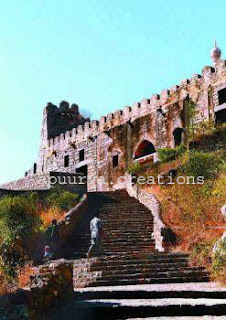On the outskirts of Hyderabad, on a 120-metre high granite hill stands the Golconda fort.
 |
| UNIQUE: Steps leading to the Durbar Hall. |
 |
| IMPRESSIVE: A view of the grand portico. |
Have you ever wondered where one of the world's largest and most prized diamonds, the Kohinoor, that now adorns the British crown, came from? This remarkable stone was found in the former treasure trove of diamonds in India — the Golconda fort.
Located on the western outskirts of Hyderabad on a 120-metre high granite hill, the fort dates back to 1364 A.D.
Originally named Golla Konda meaning "Shepherd's Hill", it tells an interesting story. In 1143 A.D. on the rocky hill of Mangalavaram, a shepherd boy came across an idol. This was reported to the Kakatiya ruler who built a mud fort there.
The other theory is that the fort is constructed within a circle, hence the name Gol meaning "round".
Architectural delight
There are four forts with a 10 km. long outer wall, and 87 semi circular bastions, some of which are still mounted with cannons. The fort, which was formerly surrounded by a moat, has eight gateways and four drawbridges. It houses royal apartments and halls, a temple, a mosque, stables and barracks.
As you enter the fort, you arrive at the Fateh Darwaza, or the Gate of Victory, which is the main gate of the fort. The door is covered with iron spikes to prevent elephants from battering them. Next is the Balahisar, which leads to the Grand Portico. Here, one can experience the creative genius of Persian architecture. If you clap your hands at a certain point below the dome, the sound reverberates and can be heard at the topmost summit of the hill, the Durbar Hall. This technique was used to signal arrivals.
Another peculiar feature of the Golconda is the absence of doors in the fort. The chambers of officials and the royal quarters were converted into rooms using drapes tied to iron rings, which are still found on the doorways.
The water system too is unique. There are three water tanks, with a depth of 12 metres. A highly developed network was created by fitting clay pipes into the walls.
The Qutb Shahi period was a golden age in the history of Golconda. Trade, especially of diamonds and art, architecture and literature flourished. These buildings, still have amazing acoustics.
What is left of the past splendour is a pile of ruin, cold stone walls echoing the sad end of one of the most glorious dynasties in history.
A peek into the history
Nearly 200 years after the construction of the mud fort, it went into the possession of the Bahamani rulers (1364). From 1507, onwards, spanning over a period of about 62 years, the mud fort was expanded by the Qutb Shahi kings into a massive granite fort, five km in circumference. It is to these rulers, and specially to Mohammed Quli Qutb Shah, that the fort owes its grandeur. Muhammed Quli is best remembered as the great planner and founder of the city of Hyderabad. According to popular legend, the king was enamoured by a dancer, Bhagmati, from the village of Chichelam. He founded Bhagnagar to perpetuate his love for her; the name of the city was accordingly changed by the king to Hyderabad. Later, unfortunately, this magnificent piece of architecture was pounded to rubble by Aurangazeb's invading army.
(Published in The Hindu Young World dated April 29, 2005)
0 comments:
Post a Comment